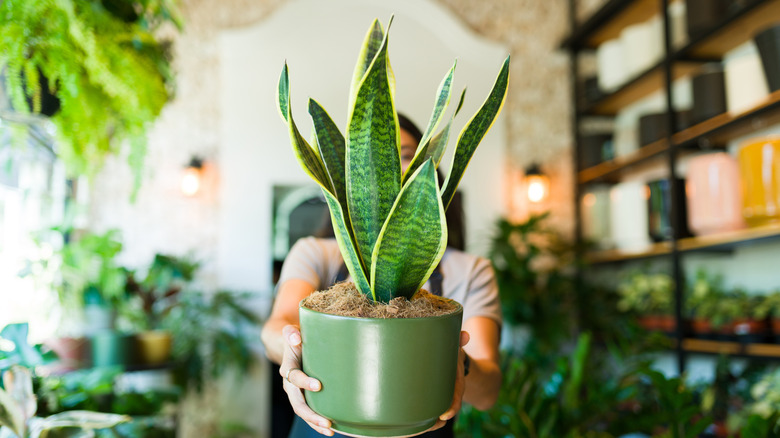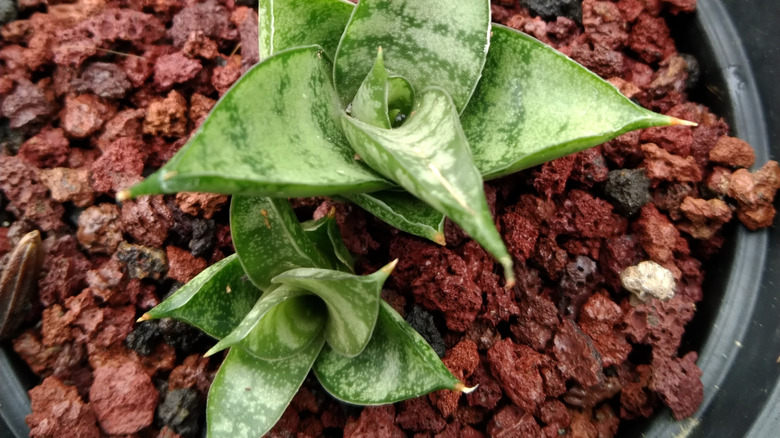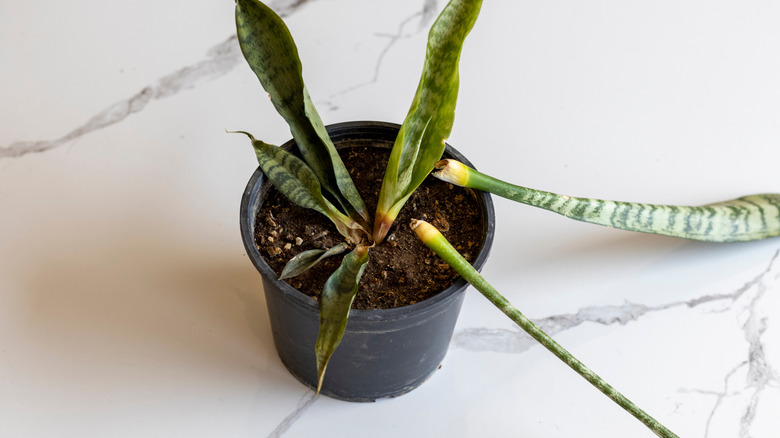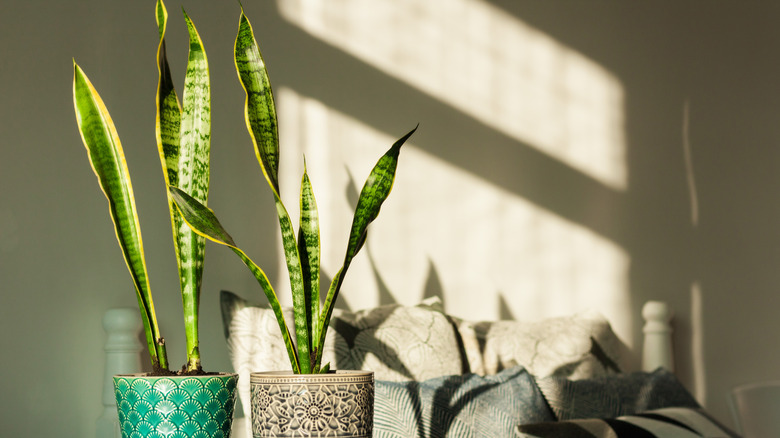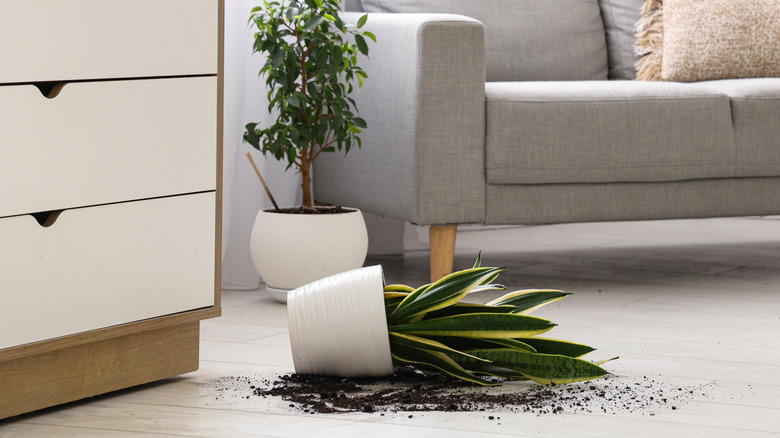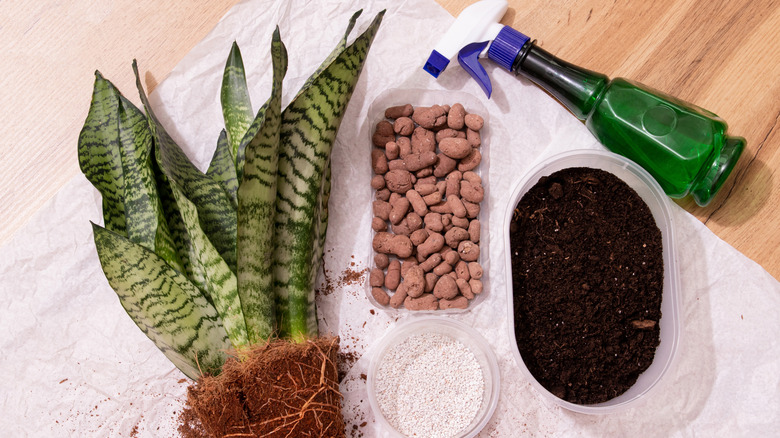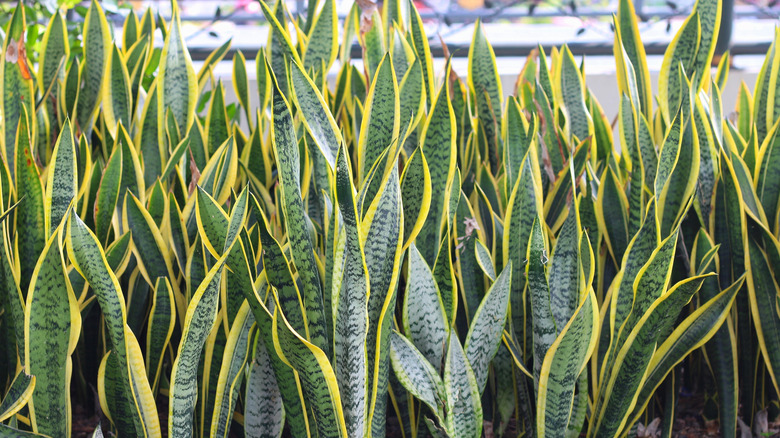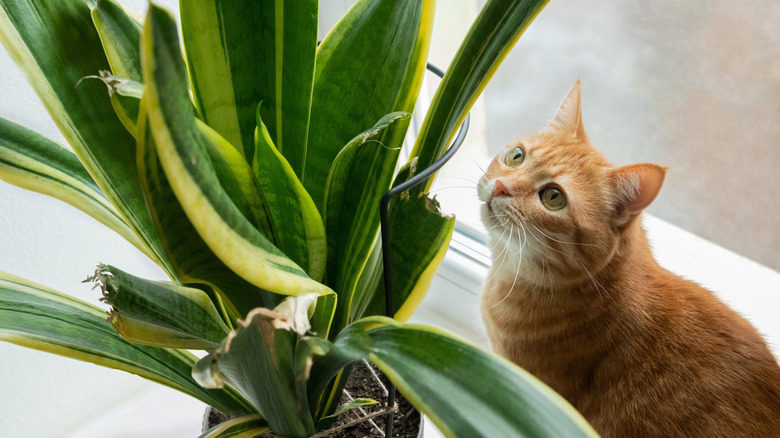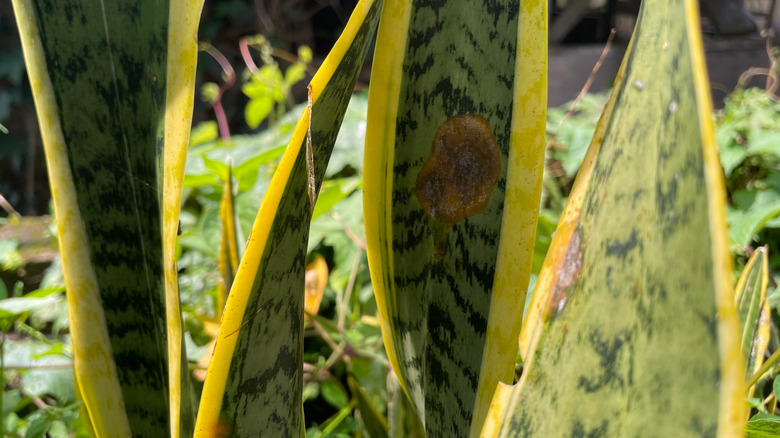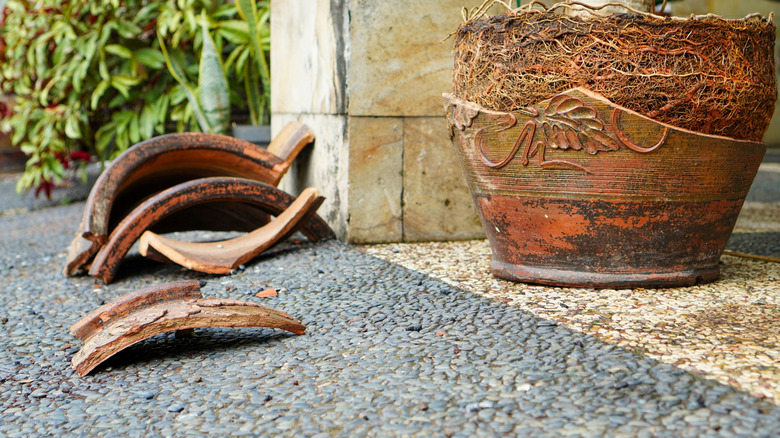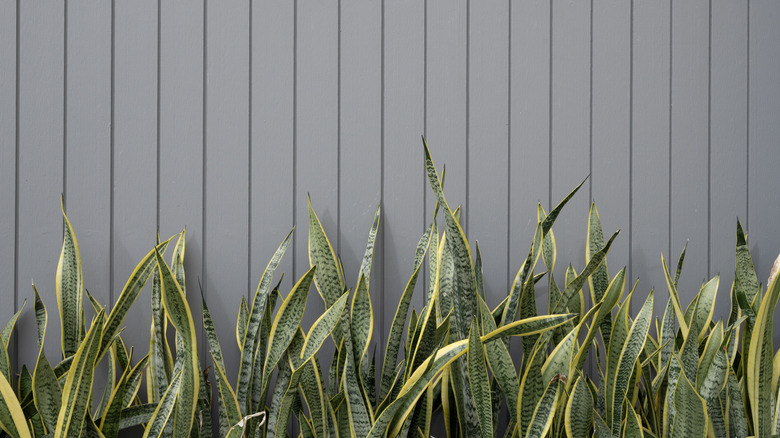Avoid Growing Snake Plants Unless You're Ready For These 10 Downsides
We may receive a commission on purchases made from links.
If you've ever checked one of those articles about houseplants even beginners can grow, you've most likely come across the snake plant (Dracaena trifasciata, formerly Sansevieria trifasciata). While we agree that they're pretty forgiving, there's more behind that resilient facade that should make you think twice before picking one up. In reality, snake plants have a surprising number of quirks that can lead to new owners getting new headaches.
So, let's break down 10 of the downsides that come along with this "unkillable" plant, so you understand what you're getting into. We'll go over what it is in the snake plant's biology that makes this such a frustrating pain point for plant parents, and include ways you can make it work should you be dead set on adding it to your home. And, if you'd rather skip the snake plant drama altogether, we'll also include a few alternative plants where we can that will mitigate the migraines, while maintaining a somewhat similar aesthetic.
It's a very slow grower
If you're someone who thrives on instant gratification, the snake plant's slow growth might test every ounce of your patience. While other houseplants might pop out a new leaves every week or so in their growing season, the snake plant takes its time, often taking as long as four to six weeks to produce a new leaf or rise a few inches. Some varieties can go months without any visible growth, which can be incredibly frustrating when you want to make sure you're doing everything right to keep it happy. The reason D. trifascitas are such wimpy growers is most likely due to its growing conditions. Many people like to put them in low light conditions — more on that later — which reduces their ability to photosynthesize. Less photosynthesis equals less growth.
If you've got enough things testing your patience in life, there are a few options. You could move the plant to a spot with bright, indirect light to encourage photosynthesis. If that's not an option, you could love the plant for what it is, embrace the "no news is good news" angle, and treat new growth as an unexpected treat. Or, you could opt for plants that have faster growth. The pencil cactus (Kleinia stapeliiformis) and the Eve's needle cactus (Austrocylindropuntia subulata) have similar upright structures to that resemble the snake plant's, but fill out their pots much faster.
It's really susceptible to rot and overwatering
Despite its reputation as indestructible, snake plants do have one weakness: overwatering. These plants are super sensitive to too much water in their soil and will develop root rot faster than you think. If you start to notice its leaves turning yellow or brown at the base, or dropping off, it's most likely on the way out — and all it took was you giving it a little too much love and attention. To understand what's going on here, you need to know its history. Dracaena trifasciata is native to dry, rocky regions of Central and West Africa, so it developed thick, fleshy leaves to hold water. Think of it like a succulent that's already prepared for drought and isn't used to being cared for so delicately. If it already has water stored in its leaves, all that water you're giving it has nowhere to go, so it sits in the soil and the plant begins to rot.
So, how can you mitigate the risk of overwatering a snake plant? Your best bet is to stop using a regular watering schedule and instead check the soil. Stick your index finger in about a knuckle deep and then pull it out. If there's soil sticking to your fingers, there's still moisture in the soil and the snake plant is good. On the other hand, if your finger comes back clean, that means the soil is dry and it's time to give your dracaena a drink. However, if you're a bit heavy handed with your water routine, its best to skip the succulents altogether and opt for a more traditional tropical plant that is more tolerant of wet soil, like Tradescantia or Colocasia.
It actually doesn't like living in your dark, windowless room
Snake plants are often touted as the plant for low-light rooms in your home or office. While it's true that they can tolerate lower light conditions, they still need some light to photosynthesize. Sadly, that dark, windowless room setup means makes your snake plant act more like its surviving, rather than thriving, while it slowly depletes its resources, losing its color and strength. If it looks droopy and pale, that's a sign you've put it somewhere way too dark and your plant is on the way out, unless you intervene soon.
Snake plants actually get the deepest colors and strongest growth when they live somewhere that has bright, indirect light. But even too much of a good thing is a problem, so adhere to the "indirect" part and make sure the light isn't directly hitting its leaves or it can scorch. If you bought the snake plant for that windowless room and are keeping it there, give it a grow light so that it can photosynthesize. There are different types of grow lights for indoor plants, but even this little LORDEM Grow Light would work great because it's full spectrum, has a timer, and can be staked into the pot's soil, giving your dracaena the crucial light it needs. Unfortunately, there aren't alternative, similar-looking plants we can recommend for low lighting setups without adding additional lighting, so just pop on a grow light and make your plant happy.
Some can become top-heavy and unstable
Snake plants are known for their sturdy, upright leaf structure, but some varieties can take this to the extreme, becoming so tall that they're now top-heavy and unstable in their pot. This is due to those thick, fleshy leaves. While they're great for storing water, all of that water weight makes it hard for them to stay upright in a narrow or lightweight pot. And if you're using dry soil that offers less ballast, you've got a big plant that's ready to topple over and onto your floor when you're not looking.
To keep your plant and its soil in the pot, you need to pick the right kind of pot to start with. Opt for a heavyweight material like terracotta or ceramic, rather than plastic, and make sure it's wider than the plant's typical spread. The combination of heft and width acts like a counterweight to the plant's tall foliage, ensuring it stays upright. Just remember that a wider pot means more soil, so you'll need to be conscious of how much water you're giving it to ensure you don't accidentally overwater.
You'll need to spend more money on well-draining succulent mix and amendments
Many plant parents will grab any standard bag of houseplant soil from a big box store and call it a day. This might work for some plants, but snake plants aren't it, because they need incredibly well-draining soil or you risk the previously-mentioned root rot. Yes, many popular potting mixes include some perlite to improve drainage, but do you want to risk it with a plant that's so moisture-adverse? Probably not, which is why you'll need to spend more to amend the standard soil, get a specialized succulent soil blend, or make your own potting mix customized for your snake plant's comfort level. Better rework that plant budget!
Unfortunately, there's no good way around this — you're going to need to invest a little more to keep your plants happy. Succulent/cactus soil blends are typically the lowest friction level here, as they're customized for plants just like D. trifasciata. But, if we may, we'd encourage you to try and DIY your own soil mix. It's not as hard as it sounds and there are lots of options to test with your snake plant, like lightweight expandable clay aggregate (LECA), pumice, perlite, coconut coir — start with whatever's on sale and mix it in your soil, then see how your plant likes its setup.
Its leaves can be super sharp and pointy
While their upright, architectural look is a major draw for people with limited space, that upright growth habit comes with a cost. A snake plant's thick, sword-shaped leaves are often pretty sturdy, making their edges sharp and the tops pointy. This isn't just a stylistic choice from the plant; it's a defense mechanism to protect its water supply from getting munched on by hungry herbivores. Consequently, this plant can become a bit of a safety hazard, especially in tight spaces or homes with curious pets and rambunctious kiddos.
This is one of those times where there isn't a good answer for how to lessen the downside. Sure, you could neglect it so that its leaves get sad and droopy, but that's just a slow death for your plant and probably not the intended outcome you wanted when you bought it. Instead, you'll need to opt for something a little softer, like a ZZ plant (Zamioculcas zamiifolia) or a cast iron plant (Aspidistra elatior). Both of these have that upright growth that mimics a snake plant's, but without the sharp, pointy edges that make them such a danger.
It's considered toxic to humans and pets
Despite their easygoing nature and preference for neglect, there's a crucial downside you need to know before bringing one into your home. All parts of a dracaena trifasciata plant contain toxic saponins that can cause anything from skin irritation to vomiting and diarrhea in both humans and pets. So, if you have fur babies or young children who might be tempted to nibble on those big, beautiful leaves, you need to consider whether it's worth the risk.
If you do want to keep a snake plant, you should first put it in a wide, heavy pot to give it stability so it doesn't fall over, then put it somewhere out of reach from kids and pets. You can opt for a tall shelf, on an elevated plant stand, or in a plant cabinet — just keep an eye on the humidity levels since snake plants are not fans of humid spots. Alternatively, you can skip the snake plant and get a houseplant that's non-toxic and safe for any space. Prayer plants (Maranta leuconeura), African violets (Streptocarpus), and the Christmas cactus (Schlumbergera x buckleyi) are all easygoing plants, without the harmful side effects.
Any leaf damage is often permanent
One of the frustrating parts of owning a snake plant is that any damage to its leaves tends to stick around — permanently. Unlike some plants that can bounce back from a little mishap, snake plant leaves rarely regain their sturdy, upright composure once they're bruised, broken, or bent. It's due to those thick, succulent leaves; once the tissue is damaged, the leaf can't self-repair in the way a tropical plant might.
If your snake plant gets damaged, the only thing you can really do is just live with it and be glad it's still alive. Even if you trim off the damage, the leaf won't grow any further, leaving you with a stubby reminder of whatever happened. If it's really a problem or the leaf becomes droopy, your best bet is to cut it as far down to the soil level as possible. But, there's good news here, too, as you can cut off the damage and try to propagate a new plant from the healthy spots of the pruned leaf. Snake plants propagate surprisingly easy from clippings, so chop off the bad stuff and stick the good stuff in some soil and see what happens.
They can break your beloved plant pots
Snake plants have a sneaky superpower that can lead to heartbreak if you're not careful. Their thick, vigorous rhizomes grow and expand with a surprising amount of force under the soil. As they continue to grow, they exert pressure against the walls of the plant pot, especially if they become rootbound, and will continue to push until they win. The result is cracked pots or even what looks like a plant pot explosion, leaving your beloved pot in shambles.
Of course, the first option is to save your dracaenas for the pots that aren't as cherished as others. Still, though, you've got to find the balance between your "meh" level of appreciation for a pot and its level of durability. Lightweight plastic pots just won't cut it, you've got to get something sturdy that balances out the heft of the tall leaves. That said, you can always put the plastic pot inside a sturdier pot so that the plastic acts like a protective liner, warning you before it's too late. Or, instead, just be mindful of when your snake plant needs to be repotted. Granted, they don't need a bigger pot as quickly as tropical houseplants, but checking for signs that it's time to repot every year or so is a good way to protect your pot and the plant.
It's not easy to control if you grow it outside
Snake plants don't just make good indoor plants, they're also popular outdoor plants, too. But don't take their indoor slow growth habit for granted, because planting them outside can turn them into a garden menace. Snake plants are considered aggressive spreaders thanks to those resilient rhizomes and can outcompete native plants for critical resources. They're so aggressive, in fact, that they're considered invasive in some parts of the United States, where they are heavily cautioned against planting outdoors.
There is one good reason for planting your snake plant outdoors, and that's its flower. Snake plants rarely flower indoors, but can produce the occasional rare flower when outside. If you want to let your snake plant live outside, then it should be put in a pot and not planted in the ground — or you could opt for something less invasive that has a similar look. Some Cordyline species, like the purple dazzler, have narrow leaves that resemble D. trifasciata. American aloe (Agave americana) plants are also an excellent option that enjoy the same rocky, sandy soil conditions a snake plant does, but without the aggressive, competitive behavior.
